Australia's private debt dynamics have been thoroughly explored elsewhere, but less well understood is the country's position relative to the OECD and BRIC nations. Thankfully, the Bank for International Settlements (BIS) provides a useful database of unconsolidated household, non-financial business and total sector debts to enable a meaningful comparison.
The difference between consolidated and unconsolidated debts is an important consideration. The former constitutes debt that is netted out within the sector, and only records debts owed to other sectors, while the latter is the actual debt a sector owes, irrespective of to whom. Unconsolidated debts are typically larger than consolidated debts.
Caution must be taken when using measures of consolidated debts as it assumes intra-sector solvency; an assumption the Global Financial Crisis (GFC) revealed to be precarious. Consolidated debts disguise the risk of intra-sector debts that can metastasise and threaten financial stability.
Advertisement
In retrospect, Ireland, Spain and the US are three countries that clearly experienced debt-financed housing bubbles, thus providing a useful benchmark for comparison. Australia's household debt to GDP ratio is clearly higher than both Spain and the US at their peaks, and remains only slightly below Ireland's peak.
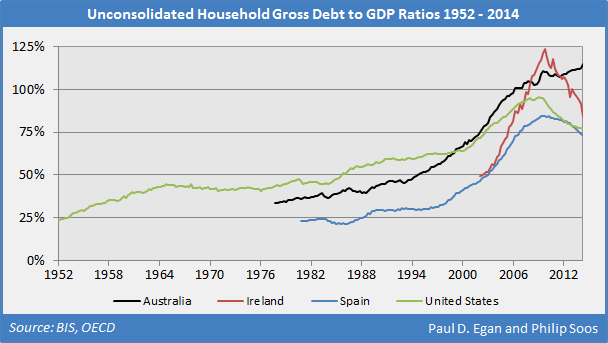
In the BIS dataset comprising 34 nations, Australia has the unenviable status of ranking fourth-highest, only below that of Denmark, Switzerland and the Netherlands. Ironically, the pathology of financial capitalism drove the world's leading social democratic state into accumulating the largest household debt ratio, peaking at close to 140 per cent in Q2 2009.
A range of factors may have boosted the income flows of Danish households and enabled such accumulation: a low unemployment rate relative to the Eurozone nations, very low income inequality, the world's highest minimum wage, and a generous social welfare system.
As of Q2 2014 (the latest available BIS data), the Netherlands is just 0.3 per cent higher than Australia. As the former deleverages, Australia should rank third-highest by the next quarter. The ratios have remained stubbornly high in both Denmark and the Netherlands despite deleveraging, as their weak economies have resulted in falling nominal GDP (the denominator).
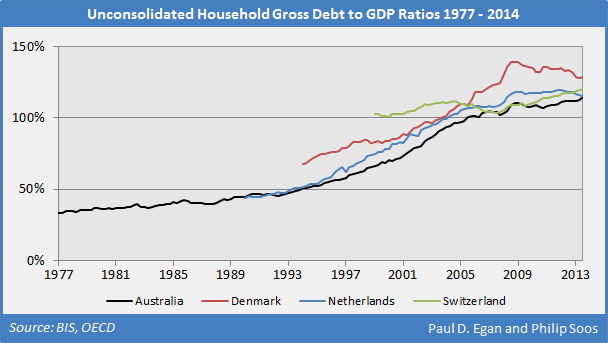
Advertisement
Australia's total debt to GDP ratio peaked at 190 per cent in Q2 2009, before falling slightly as the non-financial business debt ratio fell. As of Q2 2014, the total debt ratio was 189 per cent, and is expected to set a new peak in the next quarter or so.
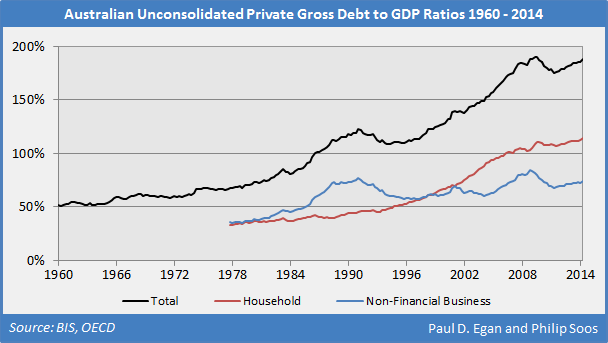
The following table lists the debt ratios for the OECD and BRIC nations. For some nations, household and non-financial business sector debts are not available, but total debt data are available for all. The non-financial business sector debt ratios are on the high end for Ireland, Luxembourg and the Netherlands, likely reflecting their generous international business taxation policies.
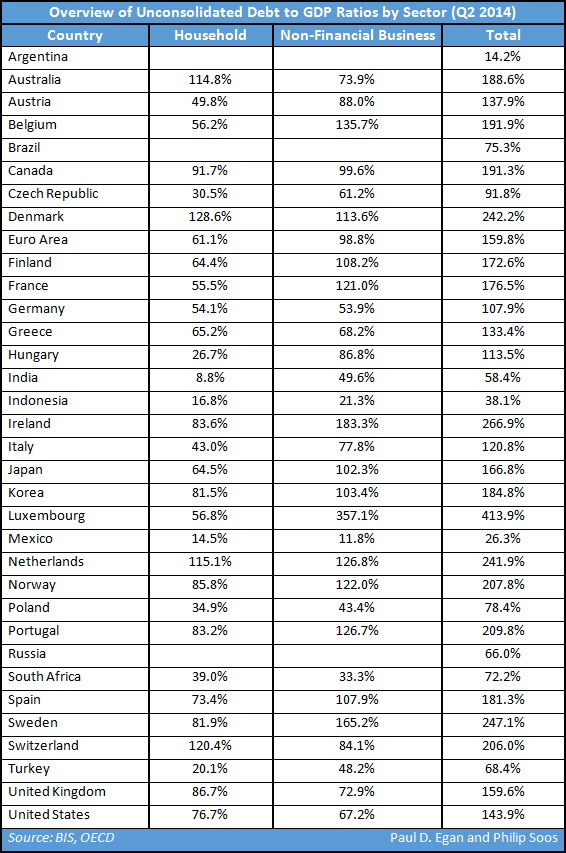
The BIS has done a commendable job in gathering long-term unconsolidated data from the OECD and BRIC nations and making it publicly available. It would be helpful if the data was further classified into categories of personal, mortgage and non-banking financial sector debt, as the latter is important when analysing banking and financial cycles.
As household debt has boomed exponentially over the last two decades, the savings of the household sector has plunged. According to the official household savings ratio provided by the ABS, it briefly became negative during the early 2000s, and then rebounded as the GFC shocked households into saving more.
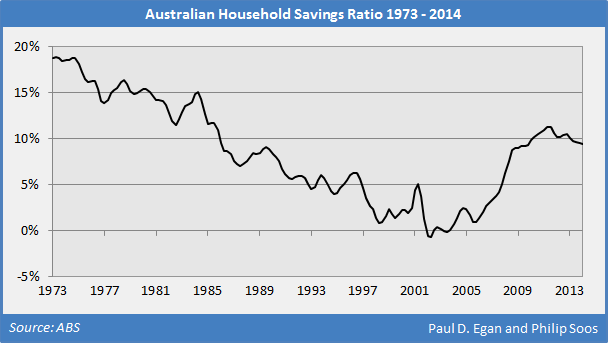
In 2013, analysis by Credit Suisse revealed that the official ratio included superannuation contributions and extra principal repayments, which arguably should not be counted as disposable savings. After controlling for these two artefacts, the ratio falls significantly, exhibiting a persistently negative trend since 1997.
The household sector's savings situation is dire, as reported by ME Bank in a 2014 report:
- Only 46 per cent of households reported the ability to save each month;
- Only 32 per cent would easily be able to raise $3,000 in an emergency;
- 50 per cent aren't confident they have enough savings to last if unemployed for three months;
- 35 per cent reported having less than $1,000 cash on hand;
- 17 per cent have less than $100 in savings;
- 60 per cent have less than $10,000 in savings; and
- In 2009, Australians were saving a median $300 per year (AMP/NATSEM).
Australia's private sector is grossly over-indebted, especially the household sector. The hysteria surrounding Australia's non-existent public budget 'emergency' is a smokescreen cloaking the critical household budget crisis. The fictional narrative concerning public debt arises from an unshakeable adherence to pseudo-scientific economic theory and class war, such as 'justified' public austerity policies which target the poor and marginalised.
Meanwhile, the public is distracted from the true threat: the unrestrained private spending spree that further enhance the power, profit and authority of the horde of private monopolists, usurers, speculators, rent seekers, free riders, financial robber barons, control frauds and indolent rich.
The current dynamics of the political and economic system means private debts will continue to spiral out of control, until the catastrophically-inefficient FIRE sector inevitably implodes. Nevertheless, the current housing booms in Melbourne and Sydney show no sign of abating in the short-term, with 2012 an opportune time to purchase according to the 'Speculative Index', which measures the irrational exuberance embedded in prices.
If the real estate fever gripping the nation does not break soon, Australia may well secure the top OECD ranking for the most over-indebted household sector. A financial crisis beckons, for history documents that extraordinary over-lending routinely precipitates chaos; falsifying expert claims that 'this time is different'.